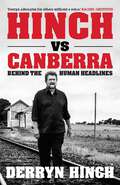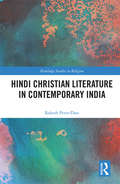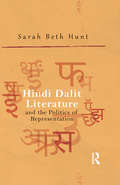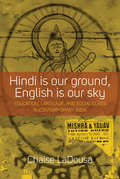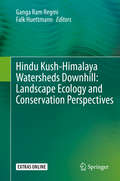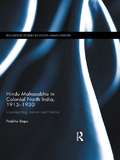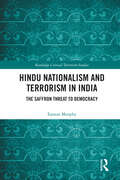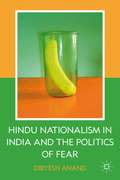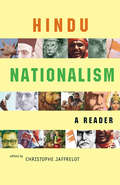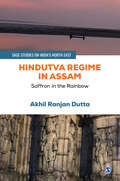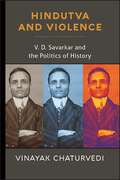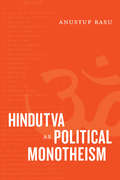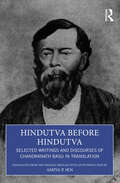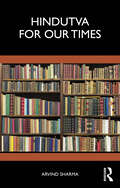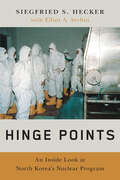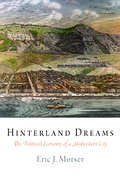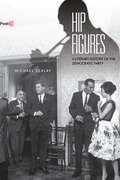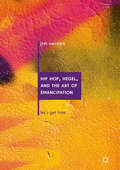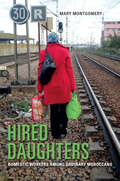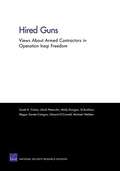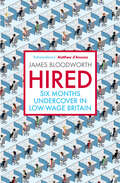- Table View
- List View
Hinch vs Canberra: Behind the human headline
by Derryn HinchAs a current affairs commentator, Derryn Hinch spent decades fighting with politicians. Then the unthinkable happened he became one. This is the inside story of Senator Hinch's first year in Canberra. Explosive, incisive, frank, brutal, and, at times, very funny.
Hindi Christian Literature in Contemporary India (Routledge Studies in Religion)
by Rakesh Peter-DassThis is the first academic study of Christian literature in Hindi and its role in the politics of language and religion in contemporary India. In public portrayals, Hindi has been the language of Hindus and Urdu the language of Muslims, but Christians have been usually been associated with the English of the foreign ‘West’. However, this book shows how Christian writers in India have adopted Hindi in order to promote a form of Christianity that can be seen as Indian, desī, and rooted in the religio-linguistic world of the Hindi belt. Using three case studies, the book demonstrates how Hindi Christian writing strategically presents Christianity as linguistically Hindi, culturally Indian, and theologically informed by other faiths. These works are written to sway public perceptions by promoting particular forms of citizenship in the context of fostering the use of Hindi. Examining the content and context of Christian attention to Hindi, it is shown to have been deployed as a political and cultural tool by Christians in India. This book gives an important insight into the link between language and religion in India. As such, it will be of great interest to scholars of Religion in India, World Christianity, Religion and Politics and Interreligious Dialogue, as well as Religious Studies and South Asian Studies.
Hindi Dalit Literature and the Politics of Representation
by Sarah Beth HuntThis study explores how Dalits in north India have used literature as a means of protest against caste oppression. Including fresh ethnographic research and interviews, it traces the trajectory of modern Dalit writing in Hindi and its pivotal role in the creation, rise and reinforcement of a distinctive Dalit identity. The book challenges the existing impression of Hindi Dalit literature as stemming from the Dalit political assertion of the 1980s and as being chiefly imitative of the Marathi Dalit literature model. Arguing that Hindi Dalit literature has a much longer history in north India, it examines two differing strands that have taken root in Dalit expression — the early ‘popular’ production of smaller literary pamphlets and journals at the beginning of the 20th century and more contemporary modes such as autobiographies, short stories and literary criticism. The author highlights the ways in which such various forms of literary works have supported the proliferation of an all-encompassing identity for the so-called ‘untouchable’ castes. She also underscores how these have contributed to their evolving political consciousness and consolidation of newer heterogeneous identities, making a departure from their long-perceived image. The work will be important for those in Dalit studies, subaltern history, Hindi literature, postcolonial studies, political science and sociology as well as the informed general reader.
Hindi Is Our Ground, English Is Our Sky: Education, Language, and Social Class in Contemporary India
by Chaise LadousaA sea change has occurred in the Indian economy in the last three decades, spurring the desire to learn English. Most scholars and media venues have focused on English exclusively for its ties to processes of globalization and the rise of new employment opportunities. The pursuit of class mobility, however, involves Hindi as much as English in the vast Hindi-Belt of northern India. Schools are institutions on which class mobility depends, and they are divided by Hindi and English in the rubric of "medium," the primary language of pedagogy. This book demonstrates that the school division allows for different visions of what it means to belong to the nation and what is central and peripheral in the nation. It also shows how the language-medium division reverberates unevenly and unequally through the nation, and that schools illustrate the tensions brought on by economic liberalization and middle-class status.
Hindrances to Good Citizenship
by James BryceFirst published in 1909. Historian, jurist, diplomat, and member of Parliament, James Bryce (1838-1922) lived one of those remarkably full and fruitful nineteenth-century public lives that remain a wonder today. He served as ambassador to the United States from 1907 to 1913 and was one of the most knowledgeable, perceptive, and sympathetic interpreters of American civilization. This is a collection of his Yale lectures.
Hindu Kush-Himalaya Watersheds Downhill: Landscape Ecology and Conservation Perspectives
by Falk Huettmann Ganga Ram RegmiThis book describes the myriad components of the Hindu Kush-Himalaya (HKH) region. The contributors elaborate on challenges, failures, and successes in efforts to conserve the HKH, its indigenous plants and animals, and the watershed that runs from the very roof of the planet via world-rivers to marine estuaries, supporting a human population of some two billion people. Readers will learn how the landforms, animal species and humans of this globally fascinating region are connected, and understand why runoff from snow and ice in the world’s tallest mountains is vital to inhabitants far downstream. The book comprises forty-five chapters organized in five parts. The first section, Landscapes, introduces the mountainous watersheds of the HKH, its weather systems, forests, and the 18 major rivers whose headwaters are here. The second part explores concepts, cultures, and religions, including ethnobiology and indigenous regimes, two thousand years of religious tradition, and the history of scientific and research expeditions. Part Three discusses policy, wildlife conservation management, habitat and biodiversity data, as well as the interaction of animals and humans. The fourth part examines the consequences of development and globalization, from hydrodams, to roads and railroads, to poaching and illegal wildlife trade. This section includes studies of animal species including river dolphins, woodpeckers and hornbills, langurs, snow leopards and more. The concluding section offers perspectives and templates for conservation, sustainability and stability in the HKH, including citizen-science projects and a future challenged by climate change, growing human population, and global conservation decay. A large assemblage of field and landscape photos, combined with eye-witness accounts, presents a 50-year local and wider perspective on the HKH. Also included are advanced digital topics: data sharing, open access, metadata, web portal databases, geographic information systems (GIS) software and machine learning, and data mining concepts all relevant to a modern scientific understanding and sustainable management of the Hindu Kush-Himalaya region. This work is written for scholars, landscape ecologists, naturalists and researchers alike, and it can be especially well-suited for those readers who want to learn in a more holistic fashion about the latest conservation issues.
Hindu Mahasabha in Colonial North India, 1915-1930: Constructing Nation and History (Routledge Studies in South Asian History)
by Prabhu BapuHindu nationalism has emerged as a political ideology represented by the Hindu Mahasabha. This book explores the campaign for Hindu unity and organisation in the context of the Hindu-Muslim conflict in colonial north India in the early twentieth century. It argues that India's partition in 1947 was a result of the campaign and politics of the Hindu rightwing rather than the Islamist politics of the Muslim League alone. The book explains that the Mahasabha articulated Hindu nationalist ideology as a means of constructing a distinct Hindu political identity and unity among the Hindus in conflict with the Muslims in the country. It looks at the Mahasabha’s ambivalence with the Indian National Congress due to an extreme ideological opposition, and goes on to argue that the Mahasabha had its ideological focus on an anti-Muslim antagonism rather than the anti-British struggle for India’s independence, adding to the difficulties in the negotiations on Hindu-Muslim representation in the country. The book suggests that the Mahasabha had a limited class and regional base and was unable to generate much in the way of a mass movement of its own, but developed a quasi-military wing, besides its involvement in a number of popular campaigns. Bridging the gap in Indian historiography by focusing on the development and evolution of Hindu nationalism in its formative period, this book is a useful study for students and scholars of Asian Studies and Political History.
Hindu Nationalism and Terrorism in India: The Saffron Threat to Democracy (Routledge Critical Terrorism Studies)
by Eamon MurphyThis book discusses terrorism and the rise of Hindu nationalism in contemporary India and examines how this movement has become a threat to democracy in the country. The work analyses the rise of Hindu nationalism, culminating in the success of Narendra Modi’s Bharatiya Janata Party (BJP), the political arm of the movement, in the 2019 Indian national elections. It offers an accessible account of the complexities and subtleties of Hindu nationalism and the dangers it poses to India’s pluralistic democracy and secularism. A major theme of the book is the role that terrorism has played in the rise of Hindu nationalism, a factor often underplayed or ignored in other studies, and it also challenges the widespread belief that terrorism is largely an Islamic phenomenon. Employing a cross-disciplinary approach, the book is highly relevant to both academics and policymakers, given India’s importance as a major global economic and military power. This book will be of interest to students of terrorism and political violence, South Asian history, Indian politics and international relations, as well as policymakers.
Hindu Nationalism in India and the Politics of Fear
by Dibyesh AnandThe representation of the Muslims as threatening to India's body politic is central to the Hindu nationalist project of organizing a political movement and normalizing anti-minority violence. Adopting a critical ethnographic approach, this book identifies the poetics and politics of fear and violence engendered within Hindu nationalism.
Hindu Nationalism: A Reader
by Christophe JaffrelotHindu nationalism came to world attention in 1998, when the Hindu nationalist Bharatiya Janata Party (BJP) won national elections in India. Although the BJP was defeated nationally in 2004, it continues to govern large Indian states, and the movement it represents remains a major force in the world's largest democracy. This book presents the thought of the founding fathers and key intellectual leaders of Hindu nationalism from the time of the British Raj, through the independence period, to the present. Spanning more than 130 years of Indian history and including the writings of both famous and unknown ideologues, this reader reveals how the "Hindutuva" movement approaches key issues of Indian politics. Covering such important topics as secularism, religious conversion, relations with Muslims, education, and Hindu identity in the growing diaspora, this reader will be indispensable for anyone wishing to understand contemporary Indian politics, society, culture, or history.
Hindutva Regime in Assam: Saffron in the Rainbow (SAGE Studies on India′s North East)
by Akhil Ranjan DuttaHindutva Regime in Assam: Saffron in the Rainbow analyses the Bharatiya Janata Party’s (BJP) strategy of appropriating cultural resources in Assam while pursuing the Hindutva agenda. In Assam, where numerous ethnic and regional political outfits have registered their electoral presence, the ‘Rainbow Alliance’ emerged as the dominant strategic tool for BJP in its electoral battles. The book studies how BJP has capitalized on people’s attachment to their ethno-regional cultures and has successfully co-opted and ‘saffronized’ the ‘Rainbow’ by bringing together diverse ethnic groups into its fold. Scrutinizing electoral strategies, BJP’s victories in 2014, 2016 and 2019, and the efforts towards dismantling consensus around the National Register of Citizens (NRC) by enacting the Citizenship Amendment Act (CAA), the book provides a holistic view of this steady ‘saffronization’. It also critically investigates BJP’s populist development agenda. From the Rashtriya Swayamsevak Sangh’s (RSS) grassroots work to the government’s policy initiatives, the book analyses the regime’s performance and ideological pursuits in depth. It highlights how BJP’s strategies in Assam are unique in some ways and how similar strategies can be seen elsewhere in India.
Hindutva and Violence: V. D. Savarkar and the Politics of History
by Vinayak ChaturvediExamines the place of history in the political thought of Vinayak Damodar Savarkar, one of the key architects of modern Hindu nationalism.Hindutva and Violence explores the place of history in the political thought of Vinayak Damodar Savarkar (1883–1966), the most controversial Indian political thinker of the twentieth century and a key architect of Hindu nationalism. Examining his central claim that "Hindutva is not a word but a history," the book argues that, for Savarkar, this history was not a total history, a complete history, or a narrative history. Rather, its purpose was to trace key historical events to a powerful source-the font of motivation for "chief actors" of the past who had turned to violence in a permanent war for Hindutva as the founding principle of a Hindu nation. At the center of Savarkar's writings are historical characters who not only participated in ethical warfare against invaders, imperialists, and conquerors in India, but also became Hindus in acts of violence. He argues that the discipline of history provides the only method for interpreting Hindutva.The book also shows how Savarkar developed his conceptualization of history as a way into the meaning of Hindutva. Savarkar wrote extensively, from analyses of the nineteenth century to studies of antiquity, to draw up his histories of Hindus. He also turned to a wide range of works, from the epic tradition to contemporary social theory and world history, as his way of explicating "Hindutva" and "history." By examining Savarkar's key writings on history, historical methodology, and historiography, Vinayak Chaturvedi provides an interpretation of the philosophical underpinnings of Hindutva. Savarkar's interpretation of Hindutva, he demonstrates, requires above all grappling with his idea of history.
Hindutva as Political Monotheism
by Anustup BasuIn Hindutva as Political Monotheism, Anustup Basu offers a genealogical study of Hindutva—Hindu right-wing nationalism—to illustrate the significance of Western anthropology and political theory to the idea of India as a Hindu nation. Connecting Nazi jurist Carl Schmitt's notion of political theology to traditional theorems of Hindu sovereignty and nationhood, Basu demonstrates how Western and Indian theorists subsumed a vast array of polytheistic, pantheistic, and henotheistic cults featuring millions of gods into a singular edifice of faith. Basu exposes the purported “Hindu Nation” as itself an orientalist vision by analyzing three crucial moments: European anthropologists’ and Indian intellectuals’ invention of a unified Hinduism during the long nineteenth century; Indian ideologues’ adoption of ethnoreligious nationalism in pursuit of a single Hindu way of life in the twentieth century; and the transformations of this project in the era of finance capital, Bollywood, and new media. Arguing that Hindutva aligns with Enlightenment notions of nationalism, Basu foregrounds its significance not just to Narendra Modi's right-wing, anti-Muslim government but also to mainstream Indian nationalism and its credo of secularism and tolerance.
Hindutva before Hindutva: Selected Writings and Discourses of Chandranath Basu in Translation
by Amiya P. SenThis book weaves the past with the present to trace and analyze the distinctive but reiterative evocations of Hindutva ideology in the modern-colonial period. It studies the concept of Hindutva as understood by its first major spokesperson Chandranath Basu, a formidable late nineteenth-century scholar-critic. The author examines the new rhetoric that has shaped Hindu ideologies in a colonial-modern context by foregrounding debates between Chandranath Basu and radical revisionists such as Rabindranath Tagore. It provides original translations of Basu’s works and brings to light a long-neglected professional literary critic.A unique contribution, this book will be an essential read for scholars and researchers of religion studies, history, postcolonialism, literature, Indian political thought, Indian history, political science, Hindu studies, Hindusim, sociology and political ideology, and South Asian studies.
Hindutva for Our Times
by Arvind SharmaThis book studies Hindu nationalism and deliberates on the forms Hindu self-assertion might take in the future. It examines the intersection of Hindu nationalism with the contemporary reality of India, as represented by a religiously plural society with a secular state, which possesses a social system characterised by caste, and one whose vision has been shaped by a mainstream version of Indian history. The ideology of Hindutva has had two major orientations—of how Hindus should relate to each other, and how Hindus should relate to the followers of other religions. The author provides a new orientation to both these dimensions of Hindutva ideology.A unique contribution, this book will be an essential read for scholars and researchers of religion studies, history, postcolonialism, nationalism, pluralism, Indian political thought, Indian history, caste studies, political science, Hindu studies, Hindusim, sociology and political ideology, and South Asian studies.
Hindu–Muslim Relations: What Europe Might Learn from India
by Jörg FriedrichsThis book reconstructs Hindu–Muslim relations from a European standpoint. Drawing from the Indian context, the author explores options for Western Europe – a region grappling with the refugee crisis and populist reactions to the growth of Muslim minorities. The author shows how India can serve not only as a model but also as a warning for Europe. For example, European liberals may learn not only from the achievements of Indian secularism but also from its crisis. Based on extensive interviews with Indians from diverse backgrounds, from politicians to social activists and from the middle class to slum dwellers, the volume investigates a wide range of perspectives: Hindu and Muslim, religious and secular, moderate and militant. Relevant, engaging and accessible, this book speaks to a broad audience of concerned citizens and policy makers. Scholars of political science, sociology, modern history, cultural studies and South Asian studies will be particularly interested.
Hinge Points: An Inside Look at North Korea's Nuclear Program
by Siegfried S. HeckerNorth Korea remains a puzzle to Americans. How did this country—one of the most isolated in the world and in the policy cross hairs of every U.S. administration during the past 30 years—progress from zero nuclear weapons in 2001 to a threatening arsenal of perhaps 50 such weapons in 2021? Hinge Points brings readers literally inside the North Korean nuclear program, joining Siegfried Hecker to see what he saw and hear what he heard in his visits to North Korea from 2004 to 2010. Hecker goes beyond the technical details—described in plain English from his on-the-ground experience at the North's nuclear center at Yongbyon—to put the nuclear program exactly where it belongs, in the context of decades of fateful foreign policy decisions in Pyongyang and Washington. Describing these decisions as "hinge points," he traces the consequences of opportunities missed by both sides.The result has been that successive U.S. administrations have been unable to prevent the North, with the weakest of hands, from becoming one of only three countries in the world that might target the United States with nuclear weapons. Hecker's unique ability to marry the technical with the diplomatic is well informed by his interactions with North Korean and U.S. officials over many years, while his years of working with Russian, Chinese, Indian, and Pakistani nuclear officials have given him an unmatched breadth of experience from which to view and interpret the thinking and perspective of the North Koreans.
Hinter den Nachrichtenbildern: Warum wir unseren Augen nicht (immer) trauen können
by Michael Wegener Mirco LiefkeNachrichtenbilder prägen unsere Vorstellung der Wirklichkeit – doch wie entstehen sie? Dieses Buch nimmt die Stärken und Schwächen des globalen Nachrichtenjournalismus unter die Lupe und geht Fragen nach, die in unserer Informationsgesellschaft von entscheidender Bedeutung sind: Warum sehen wir aus manchen Regionen dieser Welt immer dieselben Nachrichtenbilder - und aus anderen gar keine? Wie arbeiten die großen Bildnachrichtenagenturen und wie bestimmen sie so die Bilder in Sendungen wie „Tagesschau“ und „heute-Nachrichten“? Wie wird in den Redaktionen entschieden, welche Bilder gesendet werden und wie wird geprüft, ob diese auch wirklich authentisch sind? Fragen wie diese beantworten die Autoren vor dem Hintergrund bekannter und weniger bekannter Nachrichtengeschichten. Auf anschauliche und zugleich theoretisch reflektierende Weise vermitteln sie, wie Redaktionen tagtäglich auf Wahrheitssuche gehen und zeigen auf, wie wirtschaftliche und politische Zwänge unser Bild der Welt trüben können.
Hinterland Dreams: The Political Economy of a Midwestern City (American Business, Politics, and Society)
by Eric J. MorserIn the 1840s, La Crosse, Wisconsin, was barely more than a trading post nestled on the banks of the Mississippi River. But by 1900 the sleepy frontier town had become a thriving city. Hinterland Dreams tracks the growth of this community and shows that government institutions and policies were as important as landscapes and urban boosters in determining the small Midwestern city's success. The businessmen and -women of La Crosse worked hard to attract government support during the nineteenth century. Federal, state, and municipal officials passed laws, issued rulings, provided resources, vested aldermen with financial and regulatory power, and created a lasting legal foundation that transformed the city and its economy. As historian Eric J. Morser demonstrates, the development of La Crosse and other small cities linked rural people to the wider world and provided large cities like Chicago with the lumber and other raw materials needed to grow even larger. He emphasizes the role of these municipalities, as well as their relationship to all levels of government, in the life of an industrializing nation.Punctuated with intriguing portraits of La Crosse's early citizens, Hinterland Dreams suggests a new way to understand the Midwest's urban past, one that has its roots in the small but vibrant cities that dotted the landscape. By mapping the richly textured political economy of La Crosse before 1900, the book highlights how the American state provided hinterland Midwesterners with potent tools to build cities and help define their region's history in profound and lasting ways.
Hip Figures: A Literary History of the Democratic Party
by Michael SzalayHip Figuresdramatically alters our understanding of the postwar American novel by showing how it mobilized fantasies of black style on behalf of the Democratic Party. Fascinated by jazz, rhythm and blues, and rock and roll, novelists such as Norman Mailer, Ralph Ellison, John Updike, and Joan Didion turned to hip culture to negotiate the voter realignments then reshaping national politics. Figuratively transporting white professionals and managers into the skins of African Americans, these novelists and many others insisted on their own importance to the ambitions of a party dependent on coalition-building but not fully committed to integration. Arbiters of hip for readers who weren't, they effectively branded and marketed the liberalism of their moment-and ours.
Hip Hop, Hegel, and the Art of Emancipation: Let's Get Free
by Jim VernonThis book argues that Hip Hop’s early history in the South Bronx charts a course remarkably similar to the conceptual history of artistic creation presented in Hegel’s Lectures on Aesthetics. It contends that the resonances between Hegel’s account of the trajectory of art in general, and the historical shifts in the particular culture of Hip Hop, are both numerous and substantial enough to make us re-think not only the nature and import of Hegel’s philosophy of art, but the origin, essence and lesson of Hip Hop. As a result, the book articulates and defends a unique reading of Hegel’s Aesthetics, as well as providing a philosophical explanation of the Hip Hop community’s transition from total social abandonment to some limited form of social inclusion, via the specific mediation of an artistic culture grounded in novel forms of sensible expression. Thus, the fundamental thesis of this book is that Hegel and Hip Hop are mutually illuminating, and when considered in tandem each helps to clarify and reinforce the validity and power of the other.
Hired Daughters: Domestic Workers among Ordinary Moroccans
by Mary MontgomeryAn analysis of the customs and traditions of employing household help in Morocco, and the evolving rural and urban views toward domestic servitude.Hired Daughters examines a fading tradition of domestic service in which rural girls familiar to ordinary Moroccan families were placed in their homes until marriage. In this tradition of “bringing up,” the girls are considered “daughters of the house,” and part of their role in the family is to help with the housework. Gradually, this tradition is transforming into one in which workers unfamiliar to their host families are paid a wage and may not stay long, but where the Islamic ethics of charity, religious reward, and gratitude still inform expectations on both sides.Mary Montgomery examines why Moroccans so often talk about their domestic workers as daughters, what this means for workers and employers, and how this is changing in contemporary Morocco. Prioritizing the experiences and perspectives of these women, Montgomery charts the tension that has developed between socially embedded, loyal domestic workers who operate within narratives of kinship and obligation and women who seek greater individualization, privacy, and self-empowerment. Hired Daughters offers a nuanced understanding of a world that bridges public and private, morality and money, family and outsiders. In doing so, it provides an intimate consideration of contemporary Moroccan households as economic enterprises and sites of navigation between the traditional and the global.
Hired Guns
by Sarah K. Cotton Megan Zander-Cotugno Q Burkhart Ulrich Petersohn Molly DuniganThis study reports the results of a systematic, empirically based survey of opinions of U.S. military and State Department personnel with Iraq war experience to shed light on the costs and benefits of using private security contractors (PSCs) in the Iraq war. For the most part, respondents did not believe that PSCs were "running wild" in Iraq, but they held mixed views on PSCs' contribution to the U.S. military operation and U.S. foreign policy objectives.
Hired: Six Months Undercover in Low-Wage Britain
by James BloodworthTHE SHOCKING INSIDE STORY OF THE GIG ECONOMY, AS ENDORSED BY BERNIE SANDERS A powerful and revelatory piece of journalism that exposes the exploitation at the heart of the low-wage economy. We all define ourselves by our profession. But what if our job was demeaning, poorly paid, and tedious? Cracking open the gig economy, journalist James Bloodworth spends six months undercover working the most grueling low-wage jobs. He lives on the meagre proceeds and discovers the anxieties and hopes of those he encounters, including working-class men and women, young students striving to make ends meet, and Eastern European immigrants. From a harrowing Amazon warehouse to Uber taxi-cabs, Bloodworth uncovers horrifying employment practices and shows how traditional working-class communities have been decimated by the move to soulless service jobs with no security, advancement or satisfaction. But this is more than an exposÉ of unscrupulous employers; this is a gripping examination of a divided society which needs to understand the true reality of how other people live and work, before it can heal.
Hirohito And The Making Of Modern Japan
by Herbert P BixWinner of the Pulitzer PrizeIn this groundbreaking biography of the Japanese emperor Hirohito, Herbert P. Bix offers the first complete, unvarnished look at the enigmatic leader whose sixty-three-year reign ushered Japan into the modern world. Never before has the full life of this controversial figure been revealed with such clarity and vividness. Bix shows what it was like to be trained from birth for a lone position at the apex of the nation's political hierarchy and as a revered symbol of divine status. Influenced by an unusual combination of the Japanese imperial tradition and a modern scientific worldview, the young emperor gradually evolves into his preeminent role, aligning himself with the growing ultranationalist movement, perpetuating a cult of religious emperor worship, resisting attempts to curb his power, and all the while burnishing his image as a reluctant, passive monarch. Here we see Hirohito as he truly was: a man of strong will and real authority.Supported by a vast array of previously untapped primary documents, Hirohito and the Making of Modern Japan is perhaps most illuminating in lifting the veil on the mythology surrounding the emperor's impact on the world stage. Focusing closely on Hirohito's interactions with his advisers and successive Japanese governments, Bix sheds new light on the causes of the China War in 1937 and the start of the Asia-Pacific War in 1941. And while conventional wisdom has had it that the nation's increasing foreign aggression was driven and maintained not by the emperor but by an elite group of Japanese militarists, the reality, as witnessed here, is quite different. Bix documents in detail the strong, decisive role Hirohito played in wartime operations, from the takeover of Manchuria in 1931 through the attack on Pearl Harbor and ultimately the fateful decision in 1945 to accede to an unconditional surrender. In fact, the emperor stubbornly prolonged the war effort and then used the horrifying bombings of Hiroshima and Nagasaki, together with the Soviet entrance into the war, as his exit strategy from a no-win situation. From the moment of capitulation, we see how American and Japanese leaders moved to justify the retention of Hirohito as emperor by whitewashing his wartime role and reshaping the historical consciousness of the Japanese people. The key to this strategy was Hirohito's alliance with General MacArthur, who helped him maintain his stature and shed his militaristic image, while MacArthur used the emperor as a figurehead to assist him in converting Japan into a peaceful nation. Their partnership ensured that the emperor's image would loom large over the postwar years and later decades, as Japan began to make its way in the modern age and struggled -- as it still does -- to come to terms with its past.Until the very end of a career that embodied the conflicting aims of Japan's development as a nation, Hirohito remained preoccupied with politics and with his place in history. Hirohito and the Making of Modern Japan provides the definitive account of his rich life and legacy. Meticulously researched and utterly engaging, this book is proof that the history of twentieth-century Japan cannot be understood apart from the life of its most remarkable and enduring leader.
